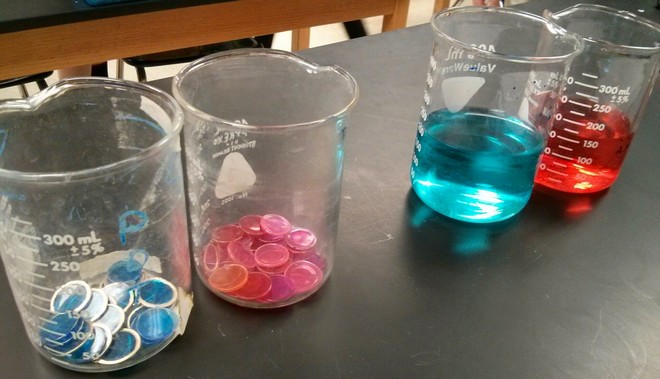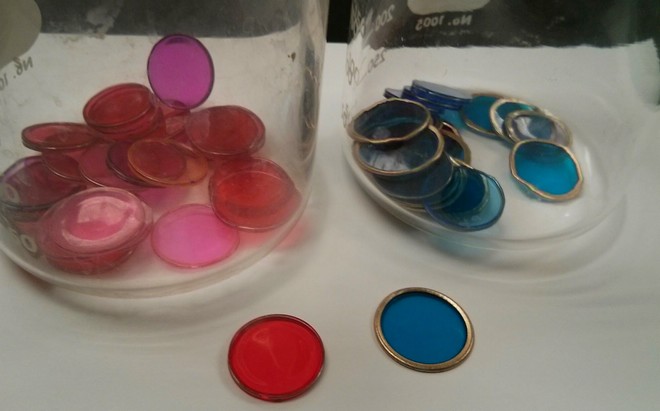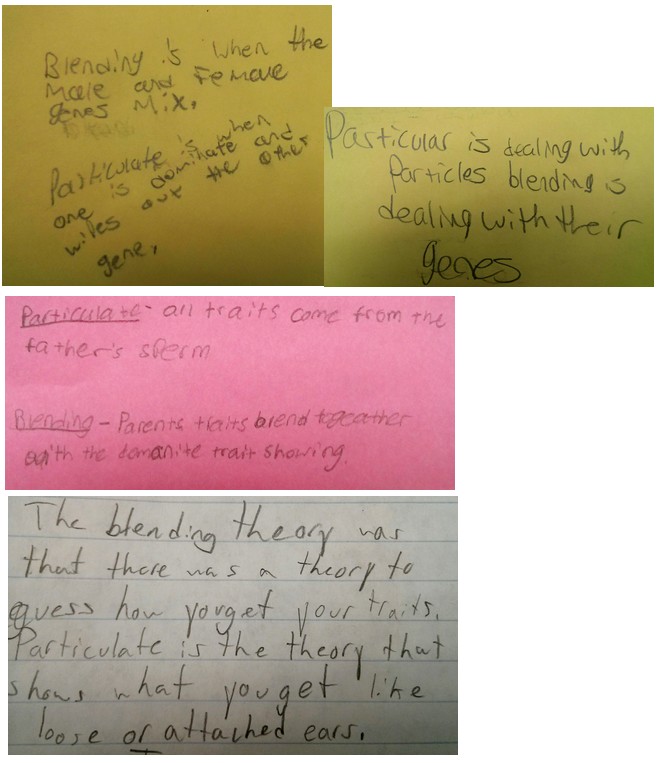My genetics unit for Freshman Biology always starts with a history lesson on Mendel and our understanding of heredity at that time. One of the main themes of this lesson is a comparison between two ways of thinking about inheritance and two competing theories: The Particulate Theory and the Blending Theory.
Students struggle with this concept. This year I decided to approach it in a different way and then use an exit ticket to determine if students actually understood the lesson. An exit ticket is a question posed at the end of class and students must answer the question and turn in the “ticket” as they leave. The question should be open-ended and provide a snapshot to the teacher of whether the student “gets it.”
To compare the two theories, I used food coloring and bingo chips. The food coloring or red and blue were used to represent the Blending Theory, that when two organisms produced offspring, that the offspring contained traits that were a blend of the parents, in this case: purple.

I carefully explained Mendel’s discovery that some traits would disappear in one generation and then reappear in the next. The bingo chips represented Mendel’s “factors” to illustrate how they don’t blend together, but instead are inherited together. Instead of a purple outcome, one factor covers up or hides the other, so you end up with one color, the dominant one, visible in the next generation. (For the demonstration, I said the blue was dominant over red.)

Mendel’s experiments were written on the board and students copied them to their notebook. It included a visual representation of his Parental Generation (RR x rr) and First Filial Generation (Rr) and then finally the 3:1 ratio he observed in every F2 generation. My students seemed to have no trouble understanding this, and some even said they had learned it in middle school. At the end of the hour, I asked to write and exit ticket to answer this question:
What is the difference between the Particulate Theory and the Blending Theory of Inheritance?

1) “Blending is when the male and female genes mix. Particulate is when one is dominant and wipes out the other gene.
2) “Particular is dealing with particles blending is dealing with their genes.”
3) “Particulate – all traits come from the father’s sperm Blending – Parents traits blend together with the dominant trait showing.”
4) “The blending theory was that there was a theory to guess how you get your traits. Particulate is the theory that show what you get, like loose or attached ears. “
Of the three exit tickets, there’s probably only one of them that actually shows understanding of the topic, though the writing was rather crude. #1 ticket is pretty close to the learning outcome for the day. The rest show misconceptions and lack of understanding. The beauty of using the exit ticket is that it took me less than 5 minutes to flip through each one and sort them into two piles: the “gets it” and “doesn’t get it” pile. I can then use that information to tailor the next day’s lesson to address the misconceptions.
Some Issues with Exit Tickets
It can be a bit time consuming to end every class with this activity. I have tried to use twitter and electronic tickets, but they tend to complicate a simple activity. You end up with people that can’t log in, can’t use #hashtags properly, don’t have twitter or other app. I used color paper and post-its to improve engagement, kids seem to like that better than just tearing off a page in their notebook.
Getting kids to take it seriously when they know it’s not for an actual grade can also be challenging. I often showcase the really good ones the next day or on a bulletin board and offer rewards to the those that had the best explanation. For those that really resist doing these, then the idea of it being an EXIT ticket comes into play. They stay after class until it’s down to my satisfaction. I haven’t used these as much this year as I’ve liked to, and I’m still making adjustments.

